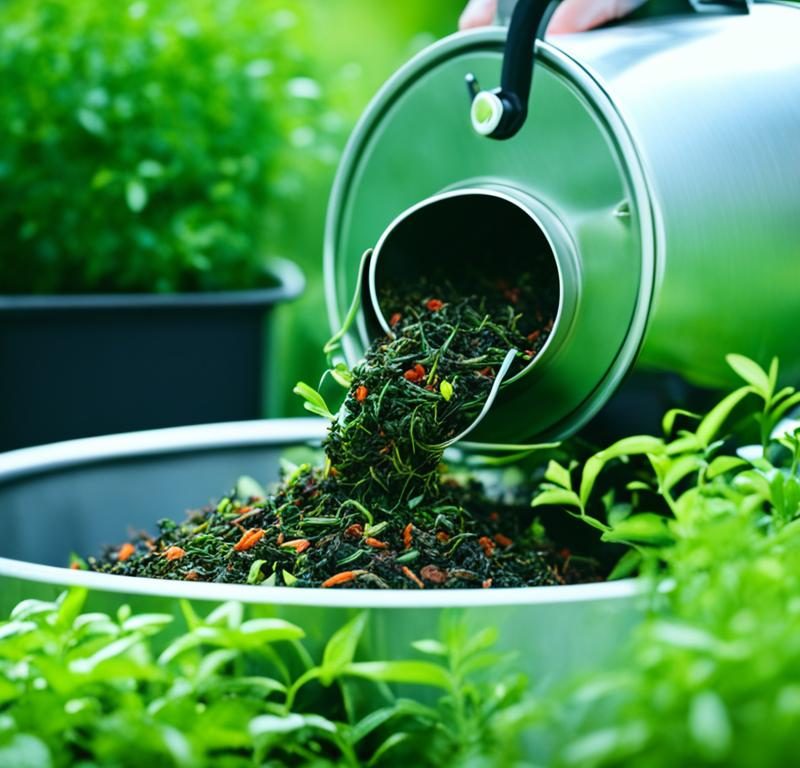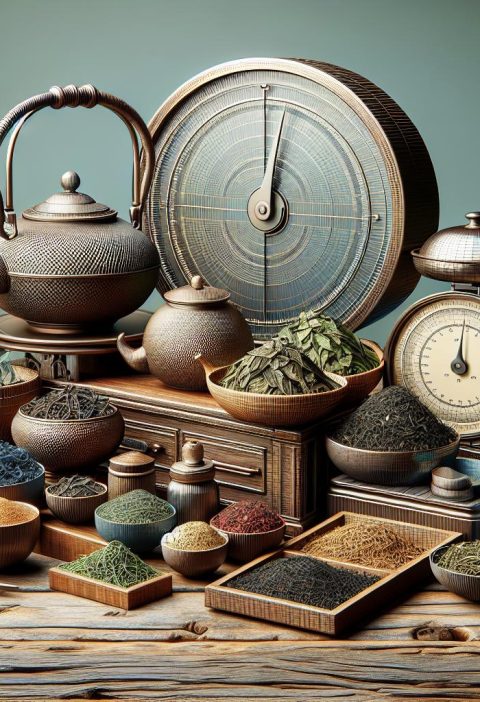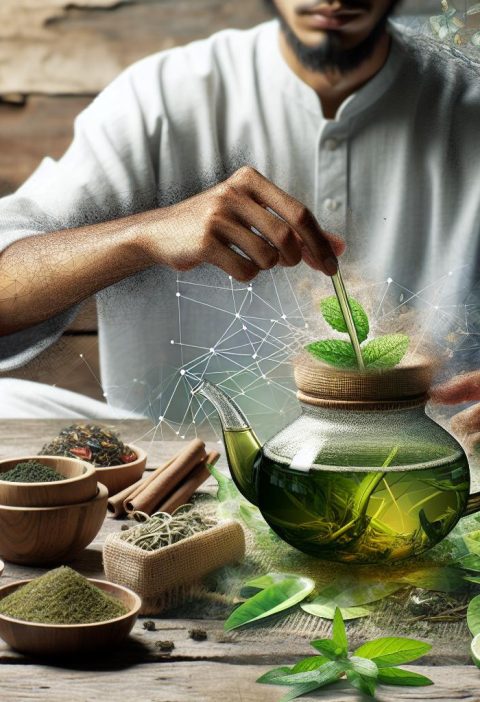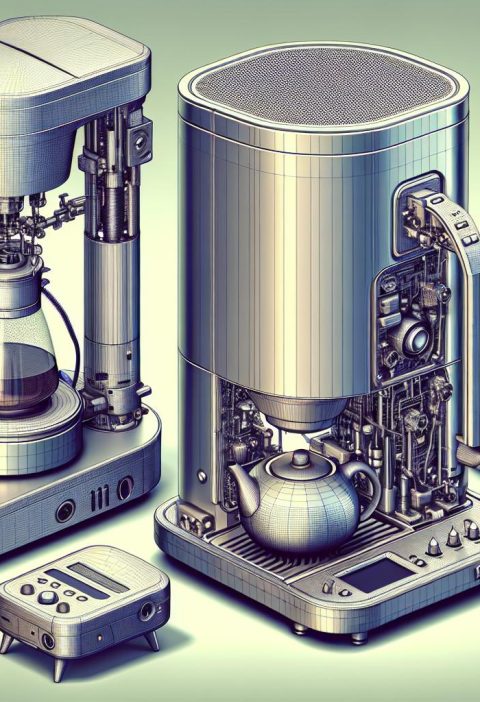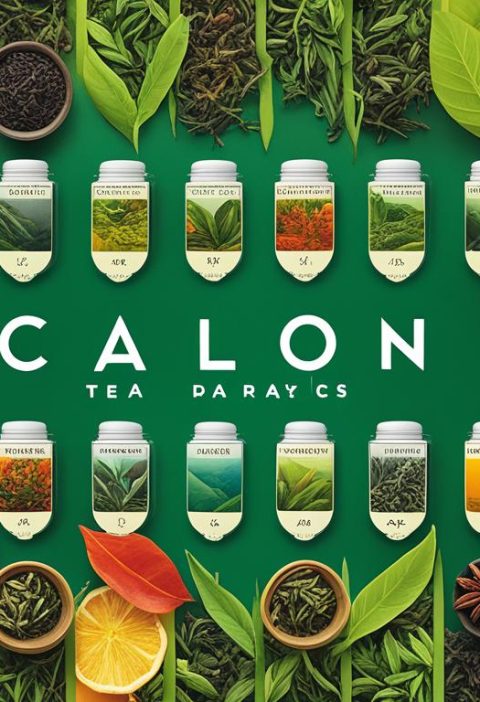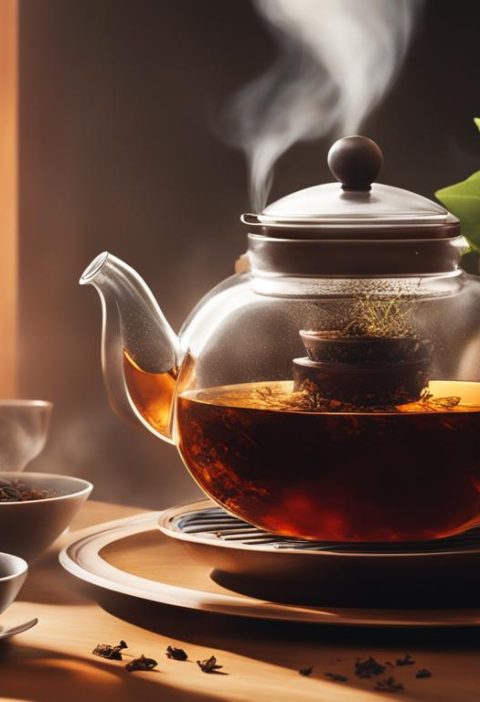Reusing tea leaves is not only a cost-effective way to maximize your tea consumption, but it also promotes sustainability and reduces waste. By exploring creative ways to reuse tea leaves, you can save money and contribute to a more eco-friendly lifestyle. Let’s discover tips and ideas for reusing tea leaves and embracing the benefits of sustainability.
Key Takeaways:
- Reusing tea leaves helps you save money and reduce waste.
- There are numerous creative ways to reuse tea leaves for different purposes.
- By reusing tea leaves, you can contribute to a more eco-friendly lifestyle.
- Experiment with steeping techniques to maximize the flavor of reused tea leaves.
- Proper storage is essential to maintain the quality and freshness of tea leaves for reuse.
The Environmental and Health Impacts of Tea Bags
Tea bags not only have an impact on our environment but also raise concerns about our health and well-being. The production and disposal of tea bags contribute to environmental degradation through packaging waste and non-recyclable materials. Most tea bags are made from a combination of paper and plastic fibers, which makes them difficult to recycle. As a result, they often end up in landfills.
In addition to their environmental impact, there are quality differences between loose leaf tea and tea bags. Loose leaf tea is generally of higher quality as it allows the leaves to expand and infuse properly in hot water. On the other hand, tea bags restrict the expansion of tea leaves, limiting their ability to release their full flavor.
To illustrate the differences between loose leaf tea and tea bags, here is a comparison:
| Loose Leaf Tea | Tea Bags | |
|---|---|---|
| Quality | Higher quality | Lower quality |
| Flavor | Rich and nuanced | Milder and less complex |
| Environmental Impact | Less packaging waste | More packaging waste |
Choosing loose leaf tea over tea bags not only reduces packaging waste but also allows you to savor the full potential of the tea leaves. By using less tea per cup, you can still enjoy a flavorful brew while minimizing the negative environmental and health impacts associated with tea bags.
How to Reuse Tea Leaves for Multiple Infusions
When it comes to enjoying loose leaf tea, reusing tea leaves for multiple infusions is a smart and sustainable practice. Not only does it help you maximize your tea leaf usage, but it also allows you to extract all the wonderful flavors and aromas tea has to offer. By following a few simple steps and experimenting with steeping times and water temperatures, you can enjoy several cups of tea from a single serving of loose leaf tea.
First, it’s important to note that not all tea leaves are suitable for multiple infusions. High-quality loose leaf teas, such as green tea, oolong tea, and white tea, are known for their ability to be steeped multiple times and offer nuanced flavors with each infusion. On the other hand, some black teas and herbal teas may not be as suitable for reusing due to their robust flavors.
To get started, here’s a step-by-step guide on how to reuse tea leaves for multiple infusions:
- Choose high-quality loose leaf tea: Opt for loose leaf teas that are known for their ability to be steeped multiple times. This ensures that you get the most flavor and aroma from each infusion.
- Use the optimal water temperature: Different types of tea require different water temperatures to bring out their best flavors. It’s essential to know the recommended water temperature for each tea variety. For example, green tea should be steeped at around 175°F (79°C), while black tea is best steeped at around 200°F (93°C).
- Adjust steeping times: As you reuse tea leaves, the infusion time should be adjusted to prevent over-extraction or under-extraction of flavors. Generally, the first infusion should be slightly longer, while subsequent infusions can be shorter. Start with steeping for around 2-3 minutes for the first infusion and then reduce the time by 30 seconds to 1 minute for each subsequent infusion.
- Enjoy multiple infusions: After each infusion, savor the unique flavors and aromas that emerge from the tea leaves. Take note of any changes in taste or aroma with each subsequent infusion.
By following these guidelines, you can make the most of your loose leaf tea and enjoy multiple cups of tea from a single serving. Not only does reusing tea leaves save you money, but it also allows you to explore the different nuances and complexities that each infusion brings.
Experimenting with steeping times and water temperatures is key to finding the optimal balance for each type of tea and personalizing your tea-drinking experience. Remember, the number of infusions you can achieve depends on the type and quality of the tea leaves. Some teas may only yield two or three infusions, while others can be steeped multiple times. Discover the joy of reusing tea leaves and unlock a world of flavors with each cup!
Repurposing Tea Leaves for Cooking and Baking
Tea leaves aren’t just for brewing a comforting cup of tea. They can also be a secret ingredient in your cooking and baking adventures, adding unique flavors and aromas to your dishes. If you’re looking to get creative in the kitchen, why not explore the wonderful world of cooking with tea leaves? Let’s dive in and discover the endless possibilities of tea-infused recipes.
Infuse flavor into your culinary creations:
- Add tea leaves to sauces and marinades to enhance the taste profile of your dishes.
- Consider infusing tea leaves into homemade ice cream for a delightful and unexpected flavor twist.
- Use tea leaves as a rub for roasted meats, imparting a delicious tea-infused crust.
- Incorporate tea leaves into your baked goods for a subtle and intriguing tea taste.
Tea-Infused Recipe Inspiration
If you’re wondering where to start, here’s a tantalizing tea-infused recipe to kickstart your culinary journey:
| Tea-Infused Recipe: | Earl Grey Lavender Shortbread Cookies |
|---|---|
| Ingredients: |
|
| Instructions: |
|
| Enjoy: | Serve these fragrant and buttery Earl Grey Lavender Shortbread Cookies with a cup of your favorite tea for a truly delightful teatime treat. |
Get ready to tantalize your taste buds and surprise your friends and family with the subtle and intriguing flavors of tea-infused dishes. Cooking and baking with tea leaves is a delightful way to add depth and complexity to your culinary creations.
Using Tea Leaves as Natural Fertilizer for Plants
Tea leaves are not only a delightful beverage, but they can also be a valuable resource for your plants. When it comes to nurturing your green companions, why not consider using tea leaves as a natural fertilizer? They are a rich source of essential nutrients, including nitrogen, potassium, and phosphorus, which are vital for healthy plant growth.
By adding used tea leaves to your compost pile or directly to the soil around your plants, you can provide them with a nutrient-rich boost. This organic alternative to chemical fertilizers not only enhances the soil quality but also promotes sustainable gardening practices.
Benefits of Tea Leaves as Plant Fertilizer:
- Supply essential nutrients: Tea leaves contain nitrogen, potassium, and phosphorus, which are essential for plant growth and overall health.
- Improve soil fertility: As tea leaves decompose, they release valuable nutrients that enrich the soil, creating a favorable environment for plant roots.
- Enhance soil structure: The organic matter in tea leaves improves soil texture, allowing better water drainage and root penetration.
- Promote healthy plant growth: Nutrient-rich tea leaves help plants grow stronger, produce more vibrant foliage, and yield better flowers or fruits.
If you’re already composting your kitchen waste, adding used tea leaves to the mix is a simple and effective way to maximize its benefits. Tea leaves can be easily incorporated into your compost pile, where they will break down and release their nutrients over time.
Composting Tea Leaves:
- Collect used tea leaves, including tea bags or loose leaves, after brewing.
- Spread the tea leaves evenly in your compost pile, alternating with other organic materials like fruit and vegetable scraps, eggshells, and yard clippings.
- Turn the compost regularly to ensure proper aeration and decomposition.
- Patience is key! It may take several months for the compost to fully mature.
If you prefer a more direct approach, you can sprinkle the used tea leaves around the base of your plants. Gently work them into the soil, being careful not to disturb the roots. This method provides a quick nutrient boost to your plants, especially if you’re cultivating them in containers or smaller garden spaces.
Remember, moderation is key when fertilizing with tea leaves. Excessive amounts may lead to nutrient imbalances or pH irregularities in the soil. It’s always a good idea to observe your plants’ reactions and adjust the application accordingly.
| Benefits of Using Tea Leaves as Plant Fertilizer | How to Use Tea Leaves as Fertilizer |
|---|---|
| 1. Provides essential nutrients | 1. Collect used tea leaves after brewing |
| 2. Improves soil fertility | 2. Spread tea leaves in compost pile or around plant base |
| 3. Enhances soil structure | 3. Gently work tea leaves into the soil |
| 4. Promotes healthy plant growth | 4. Observe plants’ reactions and adjust application |
Using tea leaves as fertilizer not only benefits your plants but also helps reduce organic waste and supports sustainable gardening practices. So, the next time you brew a cup of tea, remember to save those tea leaves and give your plants a natural, nutrient-rich treat.
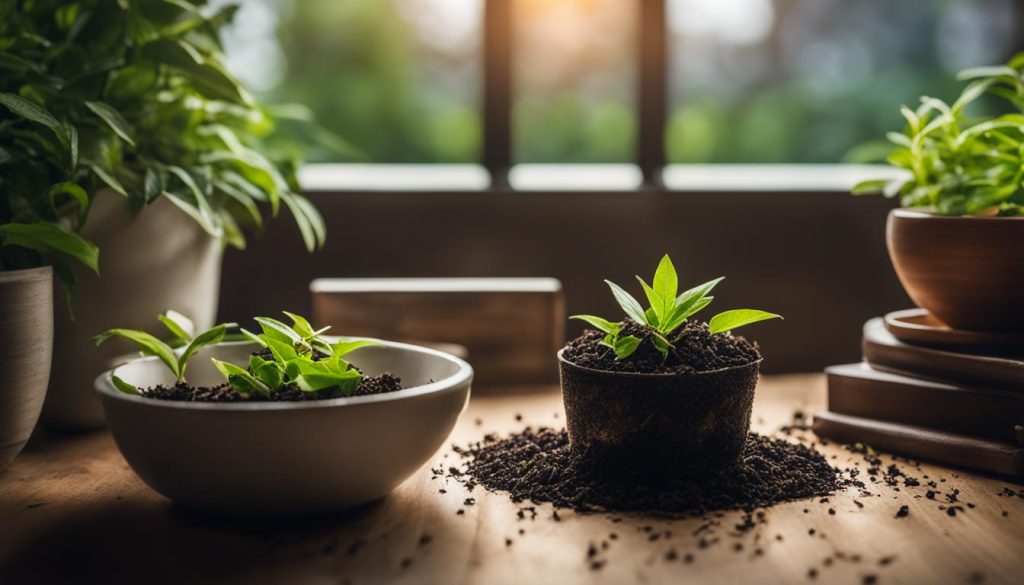
Creating DIY Skincare with Tea Leaves
Tea leaves aren’t just for brewing a comforting cup of tea. They also have incredible benefits for your skin! The antioxidants found in tea leaves can do wonders for your complexion, promoting healthy and radiant skin. Incorporating tea leaves into your skincare routine is easy and affordable, allowing you to harness the natural beauty benefits of tea. Here are some exciting ways to create DIY skincare with tea leaves:
Tea-Infused Face Masks
One of the simplest ways to incorporate tea leaves into your skincare routine is by making tea-infused face masks. These masks can help soothe and rejuvenate your skin, leaving it feeling refreshed and revitalized. Depending on your skin type and concerns, you can choose different types of tea leaves.
- Green Tea: Green tea leaves are rich in antioxidants and can help improve the appearance of your skin by reducing inflammation and fighting free radicals.
- Black Tea: Black tea leaves can help tighten pores, reduce excess oiliness, and provide a natural glow to your skin.
- Chamomile Tea: Chamomile tea leaves are known for their calming and soothing properties, making them ideal for sensitive or irritated skin.
To make a tea-infused face mask, simply steep a tea bag or a tablespoon of loose tea leaves in hot water. Allow it to cool and mix it with other ingredients like honey, yogurt, or oatmeal to create a paste. Apply the mask to your face, leave it on for about 10-15 minutes, then rinse off with warm water. Your skin will thank you for the spa-like treatment!
Gentle Exfoliation with Tea Leaves
Tea leaves can also be used as a gentle exfoliant for your skin. The texture of tea leaves helps remove dead skin cells and unclog pores, leaving your skin soft and smooth. You can create a simple tea scrub by combining tea leaves with a carrier oil, such as coconut oil or olive oil. Gently massage the scrub onto your skin in circular motions, then rinse off with warm water. Your skin will feel rejuvenated and glowing.
A Relaxing Tea Bath
Adding tea leaves to your bathwater can turn a regular bath into a luxurious and relaxing experience. The antioxidants in tea leaves can help detoxify your skin and promote a healthy glow. Simply tie a handful of loose tea leaves in a muslin cloth or put them in a tea bag and drop it into your bathwater. Soak in the fragrant and therapeutic tea bath for 15-20 minutes and let the stress melt away.
Including tea leaves in your skincare routine is a wonderful way to nourish and pamper your skin naturally. Whether it’s through tea-infused face masks, gentle exfoliation, or a relaxing tea bath, tea leaves offer a world of benefits for your skin. Unlock the power of tea leaves and discover the magic they can bring to your skincare regimen.
Adding Tea Leaves to Home Decor and Crafts
Tea leaves are not just for brewing a delicious cup of tea. They can also be a versatile and creative addition to your home decor and crafts. Whether you’re looking to add a touch of nature to your living space or create unique handmade gifts, tea leaves can be a fantastic resource to tap into. Let’s explore some inspiring ways to incorporate tea leaves into your home decor and craft projects.
Tea Leaves in Crafts
Tea leaves can be a wonderful material to use in various crafts. Their natural textures and earthy colors add a rustic and organic feel to your creations. Here are a few ideas to get you started:
- Create textured collages by gluing tea leaves onto canvas or paper.
- Use tea leaves as a unique decorating element for homemade greeting cards.
- Make tea leaf ornaments by pressing leaves between wax paper and ironing them.
- Add crushed tea leaves to homemade playdough for an interesting sensory experience.
Tea Leaves in Home Decor
Tea leaves can also be used to enhance your home’s interior design. Their natural beauty and aromatic qualities create a soothing and inviting atmosphere. Consider the following home decor ideas:
- Create a centerpiece using a glass vase filled with dried tea leaves and decorative elements like flowers or candles.
- Add tea leaves to a potpourri bowl for a natural and fragrant touch.
- Dye plain fabric with brewed tea to achieve a vintage and eco-friendly look.
- Make tea leaf sachets and place them in drawers or closets to add a refreshing scent.
Tea Leaves as Potpourri
One of the simplest and most effective ways to incorporate tea leaves into your home decor is by using them as potpourri. Potpourri made from dried tea leaves not only adds a pleasant fragrance to your space but also serves as a beautiful visual accent. You can use different types of tea leaves to create unique blends or mix them with dried flowers and spices. Place the potpourri in decorative bowls or fabric sachets and enjoy the natural aroma throughout your home.
Tea leaves have endless possibilities when it comes to crafts and home decor. Embrace your creativity, experiment with different techniques, and let tea leaves bring a touch of nature and warmth to your living space.
Exploring the Health Benefits of Reusing Tea Leaves
When it comes to tea consumption, reusing tea leaves can offer potential health benefits and contribute to a more sustainable lifestyle. Tea leaves contain antioxidants that play a vital role in supporting our overall well-being. By reusing tea leaves for multiple infusions, we can maximize the extraction of these antioxidants and other beneficial compounds, further enhancing the potential health properties of the tea.
Antioxidants are essential for neutralizing harmful free radicals in our bodies, which can lead to various health issues. By regularly consuming tea leaves rich in antioxidants, we can help protect our cells from oxidative damage and promote better overall health.
The Power of Antioxidants in Tea Leaves
Tea leaves are abundant in antioxidants, with each infusion extracting a different range and concentration of these beneficial compounds. The type of tea and the brewing method can influence the antioxidant levels in each cup. Studies have shown that certain teas, such as green tea and white tea, have higher antioxidant content than others due to minimal processing.
Antioxidants in tea leaves, such as catechins and flavonoids, have been linked to various health benefits, including:
- Reduced risk of chronic diseases, such as heart disease and cancer
- Improved cognitive function and brain health
- Enhanced immune system
- Promotion of healthy weight management
- Support for cardiovascular health
By reusing tea leaves and extracting these antioxidants through multiple infusions, we can potentially amplify these health benefits. Each infusion extracts a unique combination of antioxidants, allowing us to experience the full spectrum of their potential effects.
Potential Health Properties in Multiple Infusions
The properties of tea leaves can evolve with each infusion, offering a diverse range of health-promoting compounds. By reusing tea leaves, we have the opportunity to explore and experience the different flavors and potential health properties that emerge through each infusion.
For example, the first infusion of tea leaves may provide an energizing effect due to the presence of caffeine. Subsequent infusions might have reduced caffeine content but higher levels of other beneficial compounds, such as theanine, which promotes relaxation and mental clarity.
It’s important to note that the potential health properties of multiple infusions can vary depending on the type of tea and the brewing technique. Experimenting and finding the optimal brewing parameters for each tea variety can help us uncover the full range of health benefits.
To get the most out of reusing tea leaves, consider the following tips:
- Use high-quality loose leaf tea for optimal flavor and health benefits.
- Adjust the brewing parameters, such as water temperature and steeping time, to suit each infusion.
- Explore different tea varieties and their unique health properties through multiple infusions.
By embracing the health benefits of reusing tea leaves, we can not only enjoy a cup of flavorful tea but also support our well-being in a sustainable and cost-effective way.
Tips for Properly Storing and Reusing Tea Leaves
Proper storage is crucial to ensure the quality and freshness of tea leaves for reuse. After using tea leaves, allow them to dry thoroughly before storing them in an airtight container. This helps prevent the growth of mold or bacteria. Keep the container in a cool, dark place to maintain the flavor and aroma of the tea leaves. Follow these storage tips to ensure you get the best results when reusing tea leaves.
- Let the tea leaves dry: After each use, spread the tea leaves out on a clean surface and let them air dry completely. This eliminates excess moisture and helps prevent mold formation.
- Store in an airtight container: Once the tea leaves are dry, transfer them to an airtight container to preserve their freshness. Make sure the container is clean and dry before adding the tea leaves.
- Keep in a cool, dark place: Tea leaves are sensitive to light, heat, and moisture. Store the container in a cool and dark place, such as a pantry or cupboard, away from direct sunlight, heat sources, and humidity.
- Avoid strong odors: Tea leaves can absorb odors from their surroundings. Keep them away from strong-smelling substances like spices, herbs, or cleaning products to maintain the natural aroma of the tea.
- Label and date: To keep track of the freshness of your tea leaves, consider labeling the container with the type of tea and the date of storage. This way, you can ensure you’re using the oldest leaves first.
By following these tips for storing and reusing tea leaves, you can maintain their quality and flavor, preventing mold growth and maximizing their reusability.
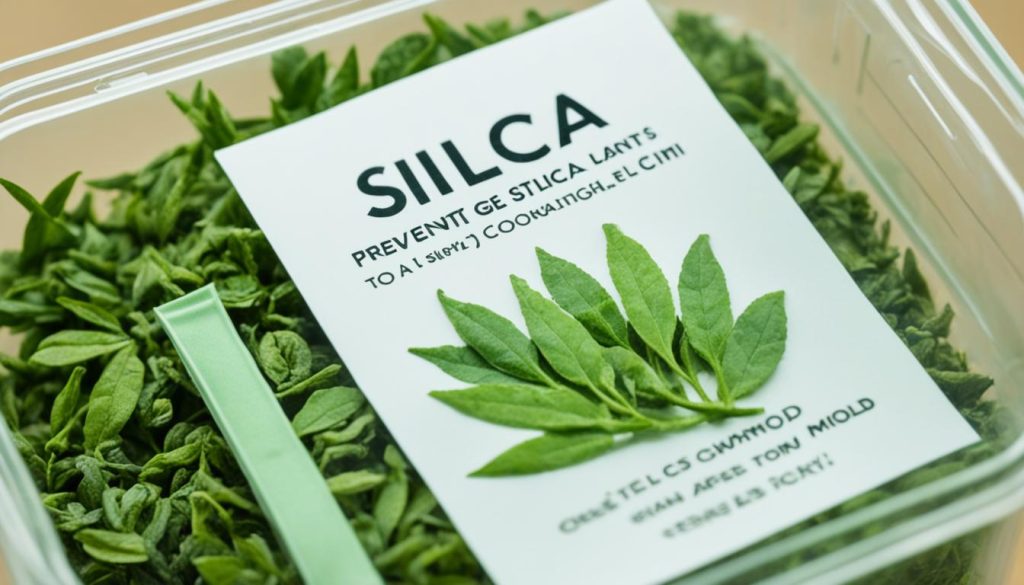
Exploring Tea Bag Alternatives for Sustainable Brewing
If you’re looking for a more sustainable brewing option, consider alternatives to tea bags. Using loose leaf tea and stainless steel or silicone tea infusers can provide a fantastic alternative that allows for multiple infusions and is eco-friendly.
By opting for loose leaf tea, you can reduce packaging waste and enjoy a more flavorful tea-drinking experience. Loose leaf tea is typically of higher quality than tea bags as it gives the tea leaves more room to expand and release their flavors. This means you can use less tea per cup and still achieve a rich and satisfying brew.
Stainless steel or silicone tea infusers are reusable and offer a convenient way to steep loose leaf tea. These infusers often come in various shapes and sizes, allowing you to find one that suits your style and preference. Simply fill the infuser with your desired amount of tea leaves, place it in your cup or teapot, and steep it in hot water for the desired amount of time. Once the steeping is complete, remove the infuser and enjoy your freshly brewed tea.
Embracing sustainable brewing practices not only benefits the environment but also enhances your tea-drinking experience. By exploring tea bag alternatives such as loose leaf tea and tea infusers, you can contribute to reducing waste while savoring the rich flavors of high-quality teas.
Benefits of Using Loose Leaf Tea and Tea Infusers:
- Reduced packaging waste compared to tea bags
- Higher quality and more flavorful tea
- Ability to customize the amount of tea used per cup
- Convenient and reusable tea infusers
- Multiple infusions with the same tea leaves
- Eco-friendly and sustainable brewing option
Conclusion
Reusing tea leaves is a practical and sustainable way to enjoy tea while reducing waste. By maximizing the usage of tea leaves through multiple infusions and exploring creative ways to repurpose them, we can save money and contribute to a more eco-friendly lifestyle. Not only does reusing tea leaves promote sustainability, but it also offers several benefits.
One of the main advantages of reusing tea leaves is the cost-effectiveness it brings. By getting multiple infusions from a single batch of tea leaves, we can stretch our tea budget and get more cups of tea for less. This is especially beneficial for loose leaf tea, as it offers more flavor and aroma compared to tea bags.
In addition to financial savings, reusing tea leaves also contributes to a more sustainable tea consumption. By reducing the amount of tea waste we generate, we help alleviate the environmental impact of tea production and packaging. This practice aligns with the growing awareness of the importance of sustainability in our daily lives.
So, let’s embrace the benefits of reusable tea leaves and make a positive impact on our wallets and the environment. By incorporating the habit of reusing tea leaves into our tea-drinking routine, we can enjoy our favorite teas while promoting a more sustainable future.
